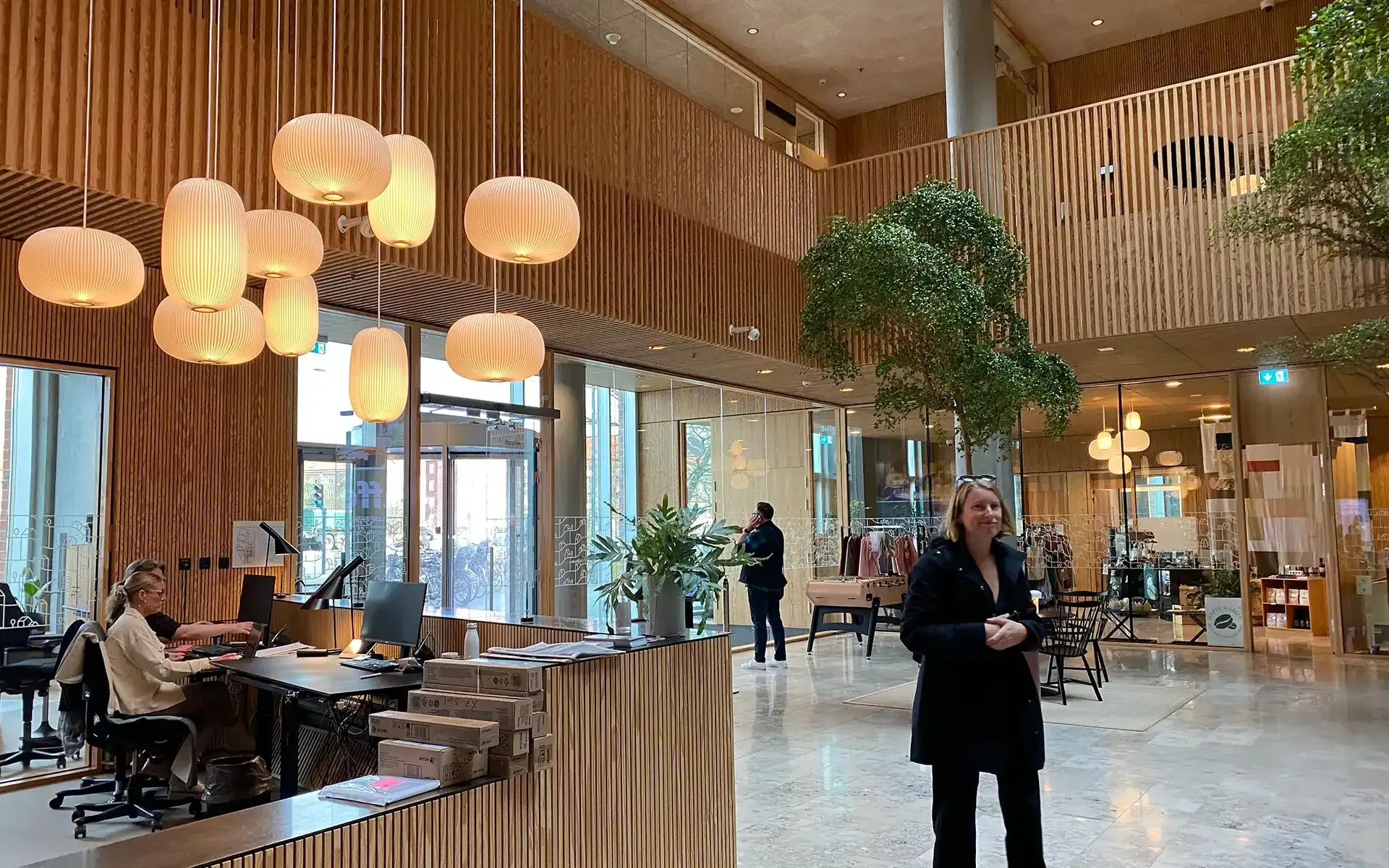Australasian social and affordable housing consultant Donald Proctor went on a study tour of European housing co-ops earlier in 2024, and we're now privileged to share in his discoveries.
Housing co-operatives currently make up less than 0.1% of Australia’s housing. This compares to about 20% in parts of Europe.
Having just been part of the European co-op study tour group organised by the Business Council for Co-operatives and Mutuals (BCCM), I am even more convinced we should and can facilitate the growth of affordable rental housing co-ops in Australia. Let me explain why it should and how it could happen.
I used to be a co-op warrior
While a student in the 1980s, I became involved in setting up STUCCO (Sydney University Housing Co-op) in Newtown, which is still going strong today as affordable, self-managed housing for low-income students. This led me to involvement with other co-ops getting off the ground with grant assistance from the Federal Government’s Local Government and Community Housing Program (LGCHP) and me joining the board of the Association to Resource Co-op Housing (ARCH) that morphed into Common Equity NSW (CENSW).
Out of the LGCHP in the 1980s and '90s, approximately 160 co-ops were established across Australia, comprising about 2,750 households (Australia’s housing co-operative sector, BCCM June 2024).
For a career, I went mainstream; to work for the NSW Department of Housing (now Homes NSW) and later a couple of Community Housing Providers (CHPs). From this vantage point, I was always disappointed to see support for new co-ops dwindle, and not just in NSW but right across Australia.
Over the next decades, public housing funding was effectively strangled, community housing grew through transfers from public housing, and Commonwealth funding increasingly chased votes through subsidies to homeownership and private market rental. Co-op funding was essentially cut off, except to fund common equity umbrella groups to ensure existing co-op compliance.
Suddenly, we have a housing crisis!
As Australia’s housing affordability crisis has risen to unacceptable levels (defined by some cynics as now affecting a critical mass of middleclass voters), some housing reforms have been realised with the establishment of NHFIC, Housing Australia and the multi-billion dollar Housing Australia Future Fund, as well as long-awaited state funding boosts such as the Big Housing Build in Victoria, the Queensland Investment Corporation funding, and recent announcements in NSW regarding public housing funding and planning reforms.
Understandably, the first round of Housing Australia funds will be directed to social and affordable housing projects driven by State Housing Authorities (SHAs) and Tier 1 CHPs. It is these bodies that have built the expertise and infrastructure to form consortia, apply for funding and manage large projects.
My view is that co-ops should be supported by the next rounds of funding as a strategic part of Australia’s future housing mix.
Why co-ops should be part of the solution
The BCCM study tour group visited many housing co-ops in Copenhagen, Vienna and Zurich. We also met with government representatives, co-op sector resource groups and banks specialising in co-op financing.
By all measures, the co-ops were fantastic and inspiring, garnering broad support in their countries, community and on all sides of politics, except maybe a few far-right wreckers. We witnessed affordable housing systems for grown-ups, sustainable and free of political wedging, with tangible levels of co-operation between tiers of government, financiers, the non-government sector and consumers. We met tenants living inclusively in great housing where they felt safe, secure, empowered and engaged in their communities.
While the co-ops and the national housing systems varied, we noted common themes that met the description of a typical co-op (see below):
A typical European housing co-op
| A typical European housing co-op | |
|---|---|
| Size | The typical European housing co-op may have grown from a group of, say, 10 households into an organisation that houses 1000s of households in many locations (estates) within the city. |
| Form | The co-op has predominantly multi-storey apartment blocks with a mix of smaller and larger apartments to cater for the desired household mix. Townhouses and low-rise flats are also common. Estates have excellent shared common facilities such as kitchen and dining areas, gardens, laundries, meeting and working rooms, libraries, bicycle and equipment storage. Car parking is minimised. A high quality of design and construction is achieved because the co-op was born out of an independently judged competition for the site and a design brief for long-term amenity, low maintenance and environmental sustainability. Apartments are typically modest in size, driven by funding guidelines and the need to keep rents low. |
| Eligibility | A co-op member cannot generally own another home, but there is usually no income test. A new member must sign up to the co-op rules, which include a commitment to participate in the management or maintenance. A member must fully occupy their apartment. For example, if children move out, they agree to move to a smaller apartment to allow for a larger family to move in. |
| Rent and member contribution | New members are required to pay a membership contribution, which is refundable (with CPI) upon leaving. Rents are charged on a cost rent basis at a rate based on floor area of each apartment. Everyone pays a similar rent per square metre. An established co-op has a lower cost rent due to more sunk costs over time. Low-income members who cannot afford the cost rent can generally obtain income support from government (similar to CRA). Also, for temporary hardship, the co-op assists members using its 'solidarity fund', which accumulates from part of rental income. Members also contribute their time each week to a duty or project agreed by the co-op. |
| Governance | Resident members are elected to the local estate management committee, and then they may represent their estate at the co-op board. The larger co-op board will employ professionals to manage day to day matters. The co-op may also vote a member to represent the co-op on the board of a sector-wide resourcing organisation (e.g. common equity organisation). Boards are generally co-op members only. |
| Financing | The established co-op is self-financing, but they would have received an establishment loan in the past, which has since been repaid. The co-op won a competition for land made available by the city government, which has a significant land bank for this purpose (e.g. a Landcom or Vic Urban). Winning the competition gave the co-op the right to lease the land from the city for an initial period of 65 years with option to renew if still a viable co-op. The co-op development was funded initially by a government co-op revolving loan scheme, mixed with a government guaranteed commercial loan from a mutual bank and member contributions. After the commercial loan was repaid, the co-op consequently repaid the government loan, making those funds available again for future co-ops. As the loans were repaid, operating costs fell. However, as the co-op has aged, the cost of capital improvements has risen. |
| Social mix | Co-op households have a mixed-income profile that supports financial sustainability and social diversity. While the majority of co-op members have low-to-moderate incomes, the co-op does not need to monitor them, nor adjust rents in response to changing incomes. |
| Relationship to other tenures | Cost rents in the co-op will generally be around 20% lower than private market rents in the neighbourhood but are not affected by market spikes in either rents or property prices. Co-op living is not exceptional – perhaps 20% of people in the city live in one. This compares with about 20% living in city-managed housing, 20% in market rental and 40% who are homeowners. The cost of homeownership in the city is generally very high, but co-op members feel safe and secure, which means that they don't have any ambitions to achieve homeownership or to escape the high and volatile cost and insecurity of market rental. |
Key takeaways and application to Australia
While the detail of our tour is being documented in the group’s upcoming report, my take on why existing and new co-ops should be supported to become a significant part of Australia’s housing spectrum is as follows:
| My takeaways | Application to Australia |
|---|---|
| 1. European housing co-ops exist at scale as a mainstream housing option. This provides a safe, secure and affordable long-term housing solution for low- and middle-income households that can have a substantial impact on improving the wellbeing of individuals and families. This is the foundation for the world’s most liveable cities. | Australian governments should foster the significant development of mixed low- and middle-income housing co-operatives that provide a better option for social and private market renters, whether they aspire to homeownership in the future or not. |
| 2. Governments, the people and banks love co-ops because they meet housing need, are reliable and self-reliant, and they become more commercially successful over the long-term. | Commonwealth and state/territory governments, Housing Australia, mutual banks and superannuation funds can collaborate to produce efficient co-op financing schemes that reduce risk and minimise interest costs. |
| 3. Financing co-ops need not be a drain on governments when adopting government-guaranteed revolving loan schemes in partnership with private sector financial institutions and member contributions. | Revolving government loan schemes in Australia, modelled on those in Denmark and Switzerland, can build to perpetual financing schemes over time. Cost rent, mixed-income profiles and member contributions can achieve long-term financial viability and independence in affordable housing. |
| 4. Competitive tender processes can ensure the best co-ops – with the best concepts, budgets and management – prosper and grow. | Housing Australia and common equity organisations are well-established to manage competitive processes where co-ops have at least equal opportunity to CHPs to obtain financial assistance for projects. |
| 5. National and city (state) governments can co-operate to foster a housing co-op sector that requires minimal ongoing support and regulation but builds a housing portfolio for benefit of current and future co-op members, and the broader community over time. | Co-ops already exist successfully in Australia, but successive governments have not designed policy that supports their growth. Policy has favoured CHP mainstream social housing over expansion of more self-reliant, affordable rental co-ops. This missed opportunity should be redressed. |
| 6. 'Tenant democracy' is a fundamental, universal characteristic of all co-op sectors. | Tenant/member participation in Australian rental housing can and should be valued and practised much more. European models show this can be done for great benefit. |
| 7. European and Australian housing and financial systems are not fundamentally different, so adopting the best aspects of European co-ops for Australia is quite feasible. | Housing Australia now has the infrastructure and funding to lead reforms subject to government direction. Australia’s private lending institutions (bank and non-bank) and private investors will be lining up to invest in co-ops under the right system settings. |
Who else is pitching for co-ops?
Since dipping my toes into co-ops again after a long absence, I have discovered a world of great people working to get co-ops back on the agenda in Australia:
- Common Equity NSW, Common Equity Housing Ltd (Victoria), Common Equity Housing SA and Co-operation Housing WA have been working tirelessly over many years to support the existing co-ops to demonstrate how good they can be.
- BCCM has adopted housing co-ops as a key part of its stable of co-ops and mutual organisations, and provides secretariat support to the Australian Co-operative Housing Alliance (ACHA), which is made up of BCCM member housing co-operatives.
- Through their Bunya Fund, BCCM has supported a number of organisations to pursue innovative co-operative housing models, such as Co-operation Housing and the Kyloring Co-Operative, Middle Ground and scalable models of secure tenure housing without ongoing subsidy, and the Community Land Trust co-op model.
- The Australian Co-operative Housing Alliance has been established to advocate for the benefits of the housing co-operative model, and the growth and diversification of the social housing sector in Australia.
- New research led by Professor Louise Crabtree-Hayes has shown the benefits of co-ops can be profound with the aspects of co-operation and participation providing a strong sense of community directly connected to positive employment, health and educational outcomes at no extra cost to the community.
- Local Government Information Unit Australia is briefing local governments about housing co-ops and how they can help promote them.
What next?
BCCM has done the groundwork – well before the tour – raising interest from housing ministers and heads of housing departments around the country. We’re now about to deliver a report to these decision-makers with recommendations to apply the benefits of European housing co-ops to the Australian housing system at scale.
BCCM’s mutual bank members are developing co-op investment funds where private investors can invest in co-op funds like property trusts, rather than directly in the private rental property market with its high entry and exit costs, managing risks, agents' fees, administration and pesky tenants.
What can ahi: members do to support the growth of co-ops?
I would suggest the first step is to open your minds to questioning some of the shibboleths of our social and affordable housing system, like:
"Tenant democracy is too hard"
(even though its proven not to be)
"The scarce housing dollar should be protected for only the poorest"
(even though this stunts viability and causes concentrations of social disadvantage, and ends up wasting larger development sites by selling part off to private buyers)
"Social housing rents should be based purely on a percentage of household income"
(which requires massive rent review admin, incentivises tenants not to increase their incomes, and limits the overall housing supply for people on the waiting list)
"Charities can’t do cost rent"
(then change the rules, if this is a problem)
"Co-ops are too hard for state housing authorities to deal with"
(whose problem is that, really?)
Then, maybe, through your organisations and the peaks, you could get on board with advocating to government policy makers for co-ops as a complementary model alongside other CHPs and public housing – just like it used to be in the 1980s.
If you work in a CHP, it's time to think about how you could partner with the co-operative housing sector to provide support and expertise to local groups in establishing co-ops. It could be lifechanging – in fact, that's highly likely.
The views in this article are those of Donald Proctor and should not be construed as the views of the tour group organisers or members.
Acknowledgement of 2024 BCCM European Co-op Tour participants:
- Liz Thomas, CEO, Common Equity Ltd (Victoria), Melbourne, Victoria
- Neil Wilmett, CEO, Queensland Aboriginal Housing Ltd, Brisbane, Queensland
- Donald Proctor, Housing Co-operative Expert, Founder of STUCCO, Student Co-operative in Sydney, NSW
- Emily Taylor, Associate, Core Collective Architects, Hobart, Tasmania
- Craig Brooke, CEO KeyInvest, Adelaide, South Australia
- Mark Smyth, CEO Beyond Bank, Coffs Harbour, NSW
- Melina Morrison, CEO Business Council of Co-operatives and Mutuals, Sydney, NSW
- Dr Sidsel Grimstad, Griffith Centre for Systems Innovation
- Beverly Wood, Tours Logistics Officer, BCCM
Share This Article
Other articles you may like







